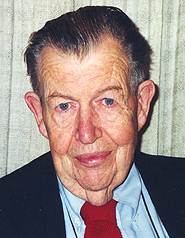Berkeleyan
Obituary
Wilson Combs
![]()
04 April 2007
Wilson Gifford Combs was expelled from Berkeley for misbehavior during the Depression. Two decades later, graduating with an M.A. in architecture, he was named University Medalist, the highest campus honor a graduate can attain, then went on to a faculty position in the architecture department. Combs died March 15 at his home in Berkeley at age 92, following a stroke.
 |
Combs was the last survivor of a small circle in Berkeley's School of Architecture assembled by William Wurster after he became its dean in 1949. Together the group embraced Wurster's "Bay Region Style" - the phrase was coined by the influential New York critic Lewis Mumford in the early 1940s - and made it a strong countervailing force in modern architecture to the then-pervasive "International Style" derived from Germany's Bauhaus School. Taking a cue from his mentor, Bernard Maybeck, Wurster espoused a less hard-edged, nondogmatic architecture sensitive to social conditions, eclectic in style, economic in presentation, suffused with light, and exhibiting a reverence for local, natural materials.
Wurster attracted a talented group of young designers sympathetic to his theories and willing to tolerate his legendary temper. Besides Combs these included, among others, Vernon DeMars, Joseph Esherick, Howard Friedman, and Donald Olsen. Each served on the Berkeley faculty for various periods of time in the 1950s through the 1970s, and each maintained a private architectural practice, many in San Francisco. Though none became a household name, it is nearly impossible to drive through a neighborhood in the Bay Area without seeing a building designed by a member of this group or one of their students or employees. From Wurster's first ranch house near Santa Cruz to Esherick's design for The Sea Ranch on the Northern California coast, their influence on the built environment was pervasive locally and spread worldwide.
At its finest, the style produced warm human-scaled buildings that reflected the post-war optimism of California and the soaring spirit that is the best of America. Stripped of subtlety and nuance, the Bay Region style later became the model for tract developers around the globe. Nevertheless, it is a measure of their success that a design considered radical half a century ago is so incorporated into our collective visual sense today as to be thought completely unremarkable. For Wurster and his followers, this would be the highest possible praise: they sought to create architecture that was the "frame, not the picture."
Combs was considered the most artistically gifted of the group. His presentation drawings in school were works of art in their own right, regularly garnering the coveted "KX" mark - the highest score at Berkeley in a system that was still based on that of the Ecole des Beaux-Arts in Paris. This culminated in his receipt of the University Medal in 1953, Berkeley's highest academic honor. His architecture would later reflect an artist's elegance together with an engineer's precision. In such diverse projects as consulting on the master plan for the new university campus at Santa Cruz or a simple house at the Wente Brothers winery, he sought to create architecture that never shouted but was simple and clear.
No one would have predicted that the young Combs would have an outstanding academic career at Cal. While an undergraduate, Combs was a member of the editorial staff of The Razzberry Press, an annual scandal sheet published by sophomores. Tame by today's standards, The Razzberry poked fun at faculty members and published a mix of cartoons and semi-salacious gossip. Each year the new issue was eagerly anticipated by the student body and dreaded by the administration. The writers and publisher of The Razzberry were an open secret on campus and they enjoyed a certain notoriety. Inevitably, each year, the perpetrators were caught and disciplined by the campus authorities. Combs was expelled in 1933 for his contributions to that year's issue.
Combs' father, employed as the chief civil engineer for the Western Pacific Railroad, ordered his son to work and found him a job on a railway survey party west of Winnemucca, Nev., at the rate of 30 cents per hour, less 50 cents a day for room and board. Wilson stayed with the railroad, working his way up from assistant surveyor to draftsman, in which position he first displayed his artistic ability. After Pearl Harbor he joined the Army and was assigned to a unit responsible for printing updated battlefield-condition maps on a nearly real-time basis. Setting up in a magazine printing shop on the outskirts of Paris, the Corps re-drew maps during the day and printed them at night, often without the benefit of much light. "Publishing an underground magazine turned out to be the best preparation for this sort of work," Combs would say later.
Back in the U.S. after the war, he passed up a scholarship to study architecture at Harvard, instead returning to Cal - against which he harbored no ill feelings. Quite the contrary, he had a running love affair with Berkeley, and for the rest of his life referred to it simply as "the University."
Combs, a fourth-generation Californian whose ancestors settled in San Francisco before the Gold Rush, was born in San Francisco May 15, 1914, the son of Era Ann Strickler and Claude Artist Combs. He attended Berkeley High School and went on to Berkeley, receiving his B.A. in 1949 (though he always claimed allegiance to his original entering class of 1935) and his M.A. in 1953. In 1941 he married Maryanna Gardner, with whom he had two sons, Gardner of Oakland and Gifford of Los Angeles, as well as six grandchildren. He is survived by all of them, and by his sister, Marian, of Oakland.
- Gifford Combs

